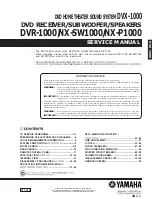
49
11. RA-4/4A High Voltage Circuit Troubleshooting
If a clean pulse appears with AC current staying well below 1.5 amps, re-connect Q8008 and Q8002 (or the short
if you disabled it this way). Apply power once again and continue monitoring the flyback pulse. Do not worry
about excessive high voltage problems. The main relay is not part of the protection circuit for high voltage. If the
high voltage rises too high or flyback current is excessive, the horizontal drive pulse will be cut off and the circuit
will stop functioning. If it goes into HV protect, proceed to the next section.
High Voltage Shutdown: This will cause seven blinks of the timer LED. The unit will not go into full shutdown.
Only the HV section will cease to operate so there will be a condition of no video with audio present (assuming a
source is being input). The variac will be a valuable tool in this case. Apply full AC and watch the current as the
unit goes into protect. A high spike of 2 amps or more is a clear indicator that an over-current condition exists. If
the circuit is engaging because of excessive HV, readings of less than 1 amp will show. If the cause is over-
current, care must be taken to avoid causing the HV output transistor to fail. If the current reading is low, the
regulation or output tuning circuits are suspect. Another possibility is the protect circuit is engaging because it
has developed a problem.
Excessive Current Draw: In most cases, the flyback transformer is the least likely suspect. Shorted windings will
affect the delicate tuning so drastically that the HV output transistor will fail. The more common causes are
excessive current demands on the secondary windings of T8002 and T8003. A quick check for shorted components
or shorts to ground on the secondary of T8002 will quickly locate the cause or eliminate this section. High
voltage blocks are more common as is a shorted CRT. Removal of these devices from the circuit is the best
procedure. All of the above items will cause rapid shutdown of the circuit. If the protect circuit does not engage
for several seconds, a CRT of loss of 200V cathode bias is likely and should expose itself with one or all of the
tubes displaying a bright raster before the shutdown.
Normal Current Draw: This could be a true high voltage problem or a malfunctioning protect component. It is not
recommended to insert a HV probe into the anode cap of a CRT to check the HV level. If the unit has excessive
high voltage, it can easily arc from the anode cap since you have lifted it. A safer way is to disconnect one of the
CRT anode lines from the HV block and try to get a reading there. Even this method is not the best. If the high
voltage is rapidly rising to extreme levels, the protect circuit may shut it down before the probe can achieve an
accurate peak reading. One method is to disable the regulation circuits as mentioned previously. If the high
voltage stays on and the probe shows lower than normal high voltage, the regulation stages will need to be
checked. If it still goes into protect, a “misfiring” component is now the part to look for. Block diagrams for both
regulators and the protect circuit will now follow with a brief description of each to assist in locating the failed
component.
Regulation
A PWM circuit is used to control high voltage at the driver and the output stage. It consists of two stages: One to
sample the high voltage from the HV distribution block and the other to monitor this voltage and generate the
appropriate PWM control.
High Voltage Monitor Stage: In Figure 11-3, this diagram illustrates how a sample of the HV level is taken from
the HV distribution block and applied to pin 5 of IC8007, a buffer, and output to pin 9 where the voltage is
compared to a 7VDC source divided down from the 135V B+. It is once again buffered and sent out by pin 1 to
the PWM comparator. The nominal voltage at this point is 1.5VDC. This is a good monitoring point for high
voltage troubleshooting. The voltage will react inversely to the actual high voltage in the HV block. By monitoring
IC8007/pin14, the HV sample feedback will indicate if the excessive high voltage is originating at this point. If the
voltage reads lower than 1.5VDC during a HV protect, the HV block and the paths routing through IC8007 are OK
since they are sending correct feedback. The regulator output stage shown in Figure 11-4 may be at fault.
Shorted or open filters may be present at HV output Q80087. If the voltage is higher than 1.5VDC, the HV block
or IC8007 is at fault.
















































